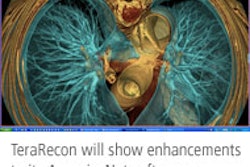(Radiology Review) Intrinsic microcalcification was the only ultrasound characteristic that reliably differentiated benign and malignant thyroid nodules, according to radiologists at Rhode Island Hospital in Providence.
According to the results of a study reported in the November issue of the Journal of Ultrasound in Medicine, intrinsic microcalcification was the only statistically reliable ultrasound criterion on which to base increased suspicion for malignancy in thyroid nodules. Radiologists at Rhode Island Hospital, Brown Medical School, reported that "Our results indicate the need for biopsy in determining further workup. All nodules that show the presence of intrinsic microcalcification should undergo biopsy, particularly if calcifications have a snowstorm appearance on sonography."
Dr. Jason D. Iannuccilli and colleagues correlated sonographic and color Doppler findings for thyroid nodules ultrasound-guided fine-needle biopsy to establish which features predicted malignancy. In a retrospective analysis of 34 malignant and 36 benign thyroid nodules, the ultrasound findings assessed included nodule size, echogenicity, echo structure, shape, border, calcification, and internal vascularity.
The researchers compared previous related studies to ensure they used the best ultrasound criteria for distinguishing between benign and malignant nodules.
Fine-needle aspiration (FNA) biopsy was performed using a 27-gauge needle under ultrasound guidance. Capillary action was used to obtain specimen during at least five passes. "Cytopathologic results for the 36 benign nodules included in the comparison group yielded 26 (72.2%) benign adenomatoid nodules and 10 (27.8%) suggestive of nodular changes associated with Hashimoto thyroiditis," they wrote. Cystic degeneration was shown in 19% of the 26 adenomatoid nodules.
Commonly, nonpalpable thyroid nodules less than 10 mm do not undergo FNA biopsy. The authors referred to a previous study by Papini et al, which established using a size cutoff of 1 mm rather that 8 mm. Using a 1-mm cutoff, they would have missed 38.7% of the malignancies they diagnosed. Also, other studies showed occult papillary carcinoma of the thyroid as small as 2 mm that had metastasized to neck nodes. The authors suggested that in order to determine the size cutoff for mandatory FNA biopsy of nonpalpable thyroid nodules, further research should be done.
They estimated the prevalence of malignancy to be 5.33% for patients with thyroid nodules. "Intragroup comparison of sonographic features among benign and malignant nodules resulted in identification of intrinsic calcification as the only statistically significant predictor of malignancy. Presence of a 'snowstorm' pattern of calcification was 100% specific for malignancy," they stated. Evaluating and comparing "echogenicity, echo structure, shape, border classification, and grade of internal vascularity" failed to differentiate between benign and malignant nodules, they determined.
"Risk for Malignancy of Thyroid Nodules as Assessed by Sonographic Criteria: The Need for Biopsy"
Jason D. Iannuccilli et al
Department of Diagnostic Imaging
Rhode Island Hospital, Brown Medical School
593 Eddy St., Providence, RI 02903 Rhode Island, USA
J Ultrasound Med 2004 (November); 23:1455-1464
By Radiology Review
November 25, 2004
Copyright © 2004 AuntMinnie.com



















